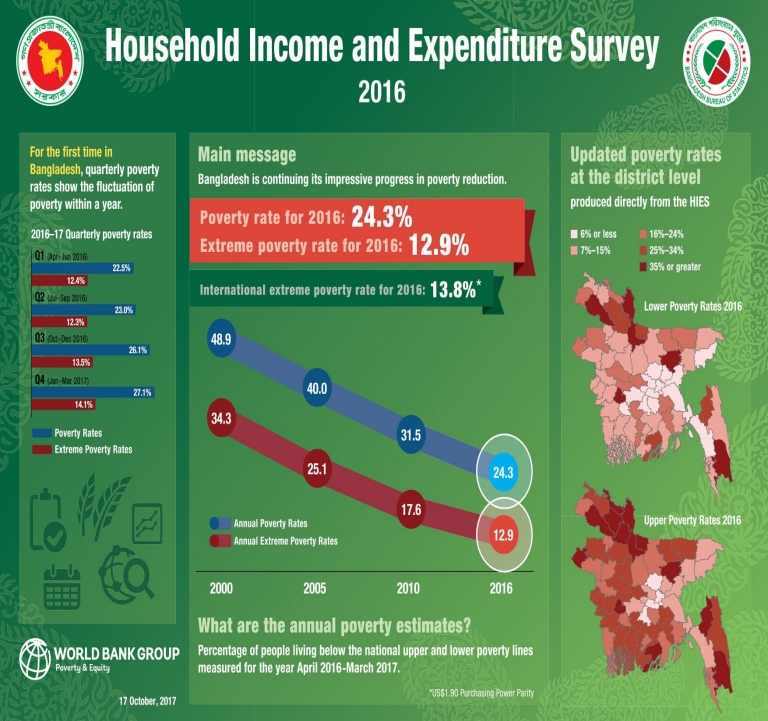The 2016/17 HIES and the official annual poverty rate – released on October 17, End Poverty Day – interviewed four times as many households as the previous HIES, allowing Bangladesh to produce poverty estimates at quarterly intervals and the district level for the first time.

STORY HIGHLIGHTS
- The 2016-17 Household Income and Expenditure Survey (HIES), for the first time, provided poverty estimates at quarterly intervals and at the district level. These data will allow smarter design and targeting of poverty alleviation programs.
- Almost 1 in 4 Bangladeshis (24.3 percent of the population) live in poverty, and 12.9 percent of the population live in extreme poverty.
- Between 2010 and 2016 poverty fell significantly but in recent years the rate of poverty reduction has slowed down. Poverty fell faster in rural areas. Urban poverty rates declined from 21.3 to 18.9 percent, while rural poverty decreased from 35.2 to 26.4 percent.
Although poverty is still high, Bangladesh has continued to make impressive progress in reducing poverty. Measured against the international extreme poverty line, poverty fell from 18.5% in 2010 to 13.8% in 2016, and the country is on track to reach the first Sustainable Development Goal of eradicating extreme poverty by 2030. Progress on reducing poverty measured by the national upper poverty line has been equally strong. In 2010, almost one third of the country’s population lived in poverty; by 2016 this had fallen to less than one-fourth. Since 2010, 8 million Bangladeshis moved out of poverty.
Despite accelerating growth, the pace of poverty reduction has slowed. The pace of economic growth increased since 2010 with GDP growing at a rate of 6.5 percent on average per year between 2010 and 2016. In contrast, the pace of poverty reduction slowed. The national poverty rate fell by 1.2 percentage points annually from 2010 to 2016 compared to 1.7 from 2005 to 2010.
Slower and more unequal household consumption growth explain the deceleration in poverty reduction. Average annual consumption growth fell from 1.8 percent to 1.4 percent. Poorer households experienced slower consumption growth than richer households and most measures of inequality increased from 2010 to 2016 whereas they had fallen in the previous five years. Bangladesh could have decreased poverty by an additional percentage point had consumption growth been distributed more equally.
Poverty continues to be much lower in urban Bangladesh, but the rate of poverty reduction was also slower. Poverty reduction in rural areas accounts for 90 percent of all poverty reduction that occurred from 2010 to 2016. Extreme poverty in urban areas did not change over time - the proportion of the urban population living in extreme poverty was 7.7 percent in 2010 and 7.6 percent in 2016. Considering the rapidly growing urbanization trend, tackling urban poverty will be increasingly important to achieve the country’s poverty reduction agenda.
Progress in reducing poverty was also uneven across divisions, with the North West seeing poverty rise. Poverty has risen in the north-west Rangpur; stagnated in Rajshahi and Khulna in the west; fallen moderately in Chittagong; and fallen rapidly in Barisal, Dhaka and Sylhet Divisions. The stronger progress of poverty reduction in the eastern regions countered the gains that had been recorded from 2005 to 2010 in reducing the welfare gap between eastern and western Bangladesh. It highlights the need for further investments to increase income growth in the west.

